Las Vegas
Packed up once again at our Arizonan base in Prescott, the rolling dice until sunrise awaited. Vegas, baby. I could only imagine the indulgent sights that lay in store smack dab in Nevada’s Mojave Desert. Sure of myself that its focal point, the Strip, would be akin to Blackpool, my hometown but on steroids. A magnet for hen and stag parties. Countless 24-hour casinos, non-stop vibrant nightlight and the reinforced promise of excitement, fame and fortune. Big budget stage-shows, Celine Deon, a real people fest. Naïvely, I thought: you’ve got to see it to believe it.
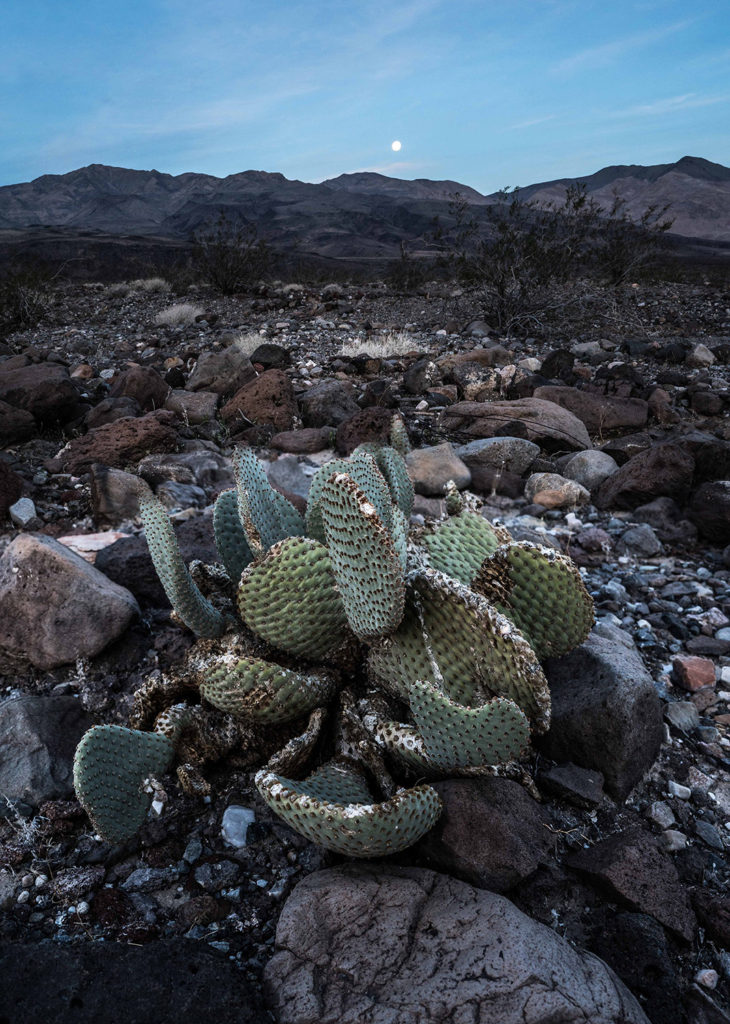
At full tilt, we merged at what I thought was dangerous speed onto Highway 95 and into the slipstream of racing vehicles. The cars fused into one entity, like a shoal of fish. All I heard was the whoosh of rubber on concrete. Like a superorganism. Spend too much time or moolah in Vegas, and you’ll feel subsumed into its superorganism.
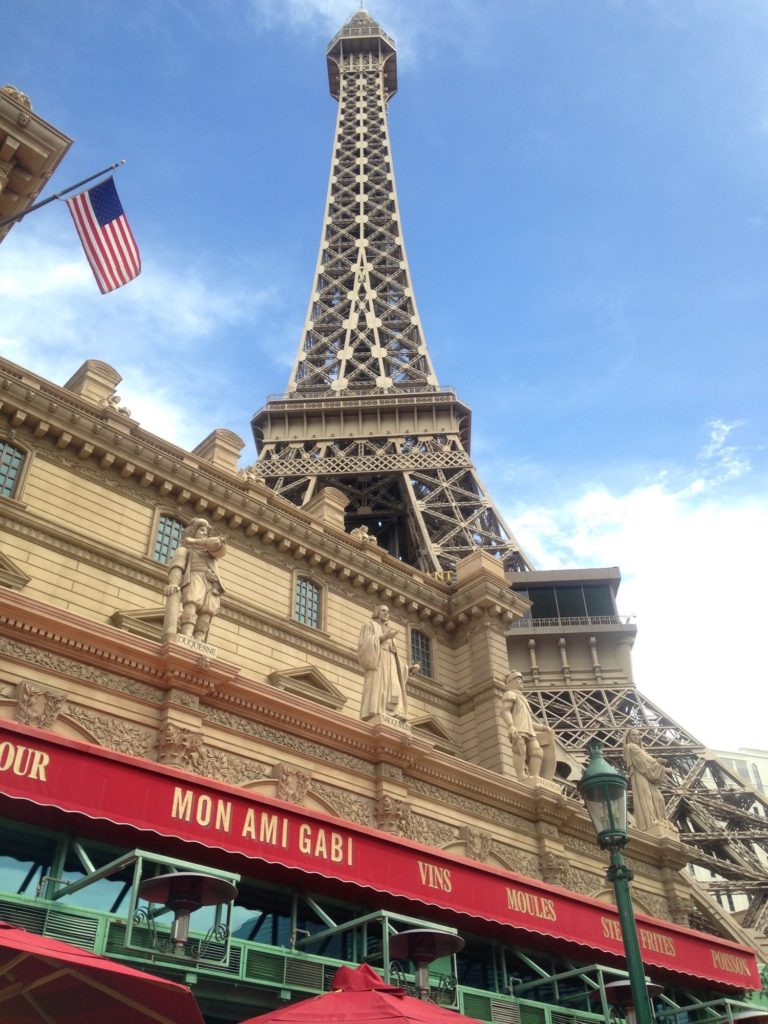
The Strip
Downtown Las Vegas cast off its conventional city self in the early twentieth century for an electric personality, where it has scintillated in kaleidoscopic colour ever since. Each building insisted upon me in a different way, leaving its imprint. The place dazzled. That was the first thing I noticed. Its molecules seemed more excited; things shimmered and flashed ranging in style from the sublime to the ridiculous. Only four miles long but the Strip’s buildings and streets put out more light than the sky sent down. I’d gone from a dark sky community in Borrego Springs to neon central.
Here, my first ten minutes in Vegas, grateful to park the bike in Fashion Show Mall for free, I encountered the Trump International Hotel. A 64-story lap of luxury gilded in 24K gold. Brilliantly, a huge billboard nearby advertised the ‘Puppetry of the Penis Show’ and a neon sign directed you to ‘Lovely Lovely Girls’. Playboy bunnies from stunning to sagging gave their most disarming smile on every street corner. Themed hotels overlooked elaborate fountains dancing to synchronised opera music. It was nigh on impossible to miss the Eiffel Tower replica among others amid grubby Disney characters touting vacationers while they supped on their 32-ounce coke. Celebrity chef restaurants and every food franchise known to the U.S. were in abundance. So. Many. Burger. Joints.
Indoors was possibly more overwhelming. I’d say it’s feasible to spend your entire visit within a labyrinth of mesmerising casino floors. Having slots of fun is aided by scantily clad waitresses eager to tend to your every whim under artificial lighting until day blurs into night. Just off the floor, most of the bars facilitate gambling so on a cushioned bar stool, you can feed your face and quench your thirst for beer and betting. Staking your hard-earned dollars on the deep-seated hopes of winning it all. How convenient. Everything else was an ongoing explosion of the gaudy and loud, the 24/7 city blowing itself to bits and my mind in the process. It was freakishly fabulous by the biggest and boldest means only known to Vegas.
Mojave Desert, Nevada
An afternoon in the resort city was about all we could handle. Venturing out of the risk-taking desert metropolis to Red Rock Canyon in the Mojave Desert with our host, Grant, meant we experienced some scenic beauty surrounding the trillion-dollar bling. Forged by tectonic plates, shaped by the wind and sun-scorched, vast russet red canyons mingled with epic mountains—the easiest win for one of the planet’s most pulsating adult playgrounds. Although the hike to the Valley of Fire proved to be longer than any of us anticipated. No one had properly translated what our eyes saw on the map to the distance our feet walked on the dirt.
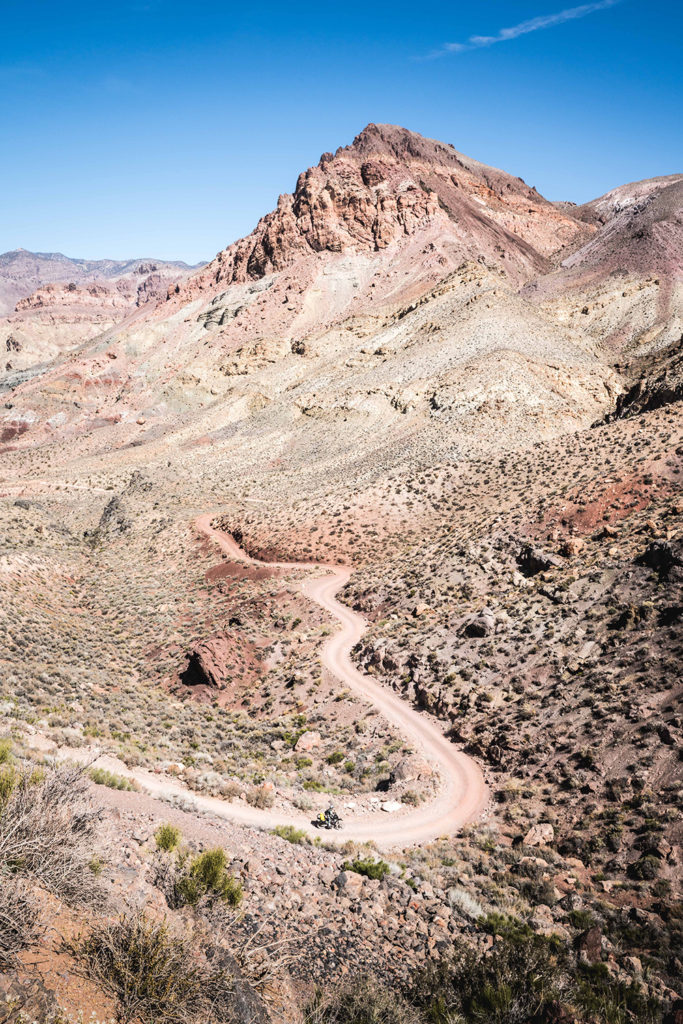
Running out of water, a local in his 4×4 saved our skins, rehydrating us as we hitchhiked in the back of his truck. Giving us quite the ending to a colourful stay. Not exactly a brush with death but I did harbour one or two concerns about dehydration, a slip or a sprained ankle, a few too many degrees of heat, a wrong turn on the trail, that could trap us beyond the easy reach of help. I’d recently read that in 2014, day hikers accounted for 42 percent of 3,409 emergencies.
Still, I chuckled out loud when Grant’s wife, Donna, admitted that the morning after the night of taking us in, she blurted to her boss in the workplace: “I’m still alive! They didn’t kill us!” Post our foray with the good-hearted pair and tongue-in-cheek, I can kind of relate to that. Happy as could be, we all immersed ourselves in nature’s unforgiving backyard but came away renewed.
Titus Canyon, Death Valley National Park

Three hours from Vegas, we arrived at Emigrant Campground, an intimate little snuggery. Situated 21-miles from the park boundary at Panamint Springs and ten miles south of Stovepipe Wells, we set up home in the desert of extremes. As towns for the boom and bust scenario go, Leadfield was situated on Titus Canyon Road in Beatty, Nevada. The adventurous backcountry road is a legacy of Leadfield, once thriving on its mining is now a ghost town. Named after Edgar Morris Titus, a mining engineer who disappeared in 1905, the year in which 13 others died from heat and dehydration. Death Valley’s deadliest year.
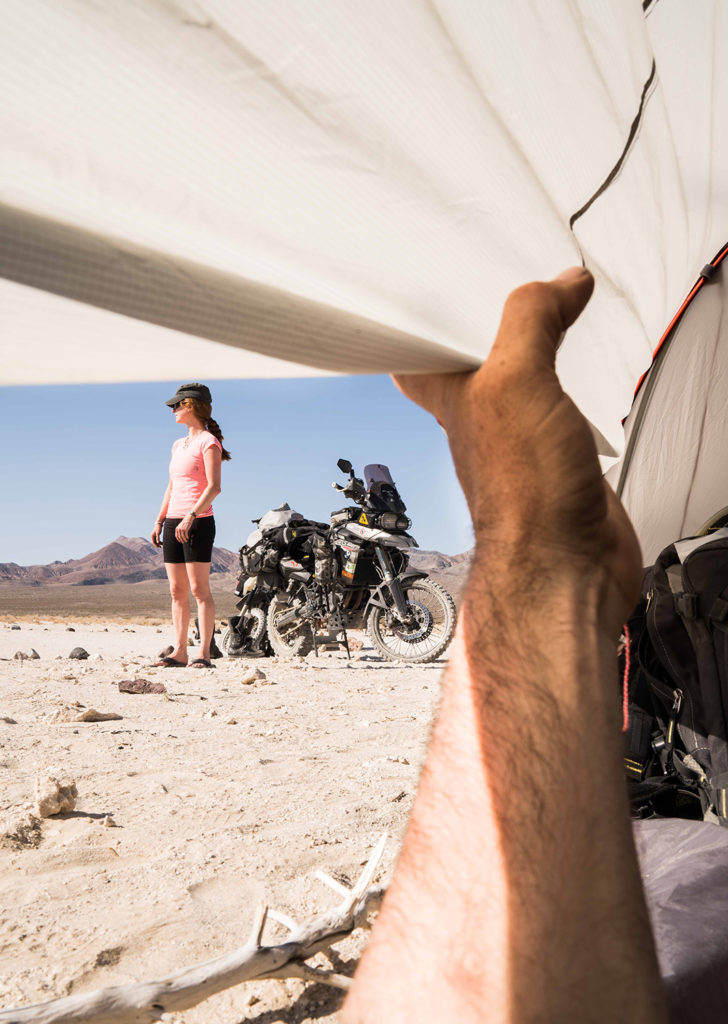
Packing up our steeds at camp, we loaded all the water we could carry from the campground’s spigot, gassed up and breakfasted in town.

And I went from “Lank Mouse” to bushy-tailed, thanks to the $4 powerful showers at the resort swimming pool. Jumping on Highway 374, a 27-mile one-way road starts a couple of miles east of the park boundary.
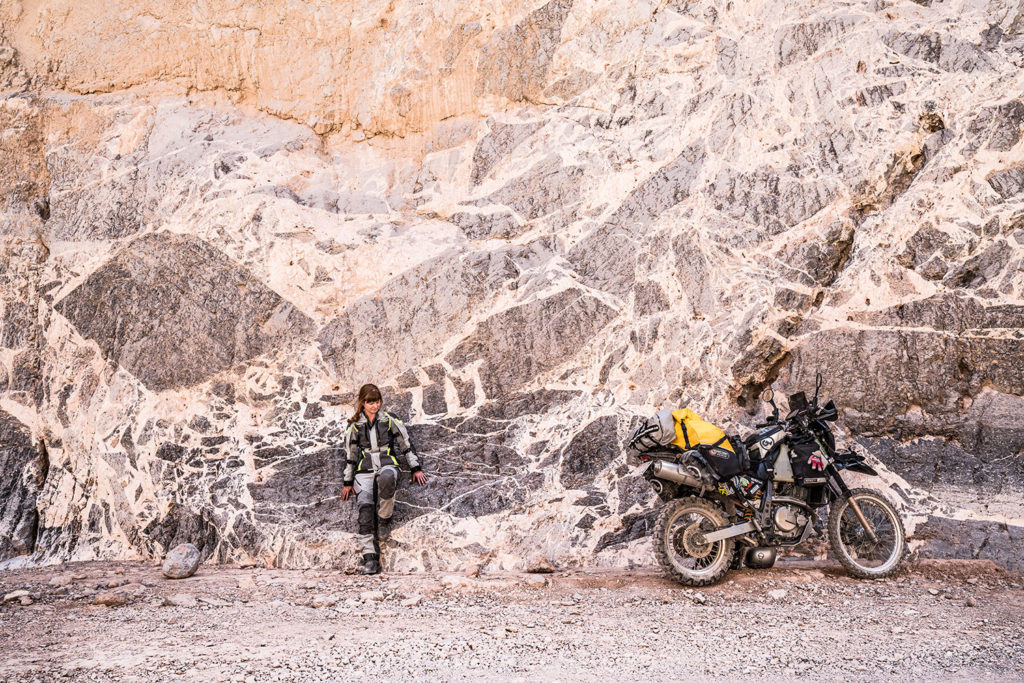
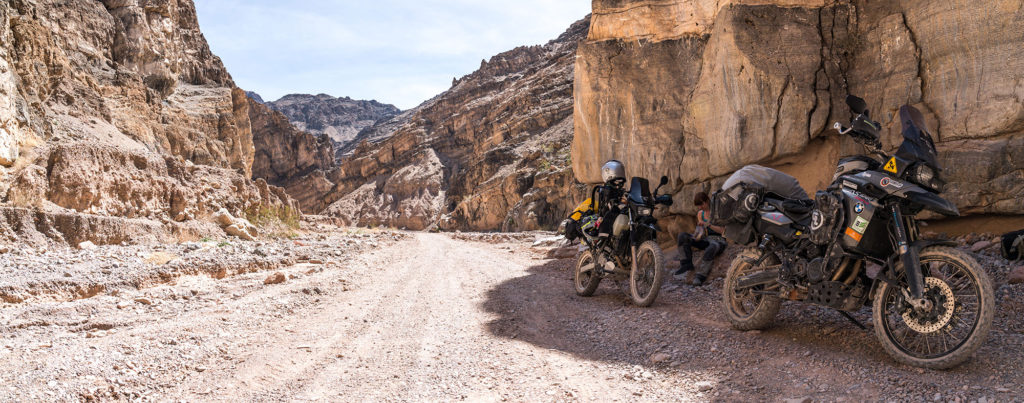
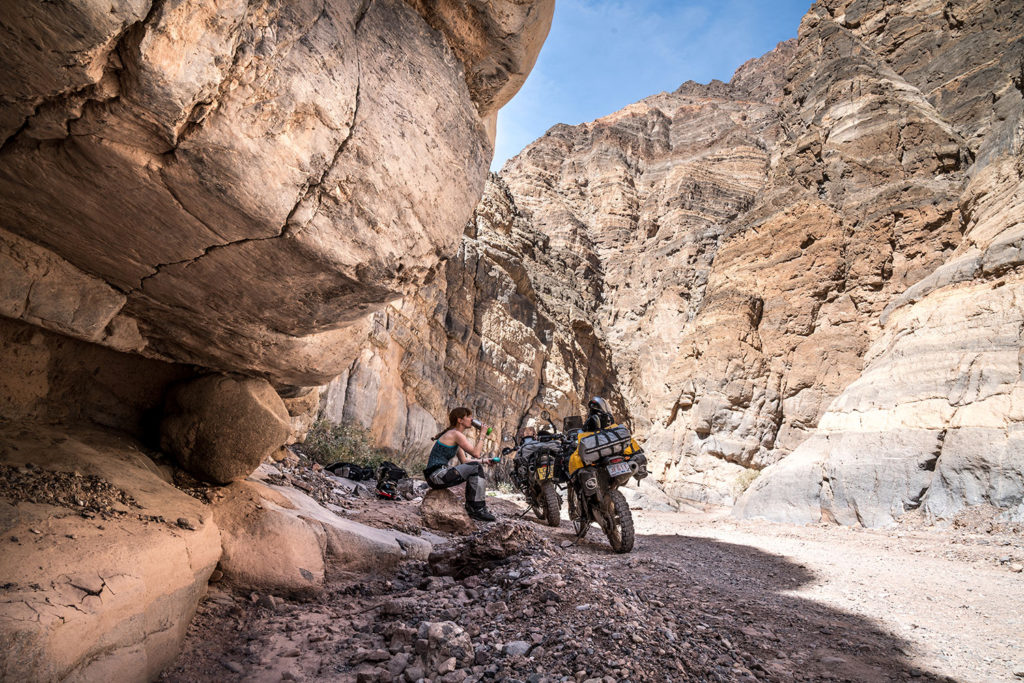
As canyons go, Titus lives up to its Greek meaning, of the giants; it’s mountains have endless supplies of ruggedness, leading us through stony dirt meandering through vivid rock formations and adorned with desert flora and petroglyphs. A spectacular finale ensued as the canyon narrowed to a winding finish at the western end. Back with a vengeance, we were killing it in Death Valley.
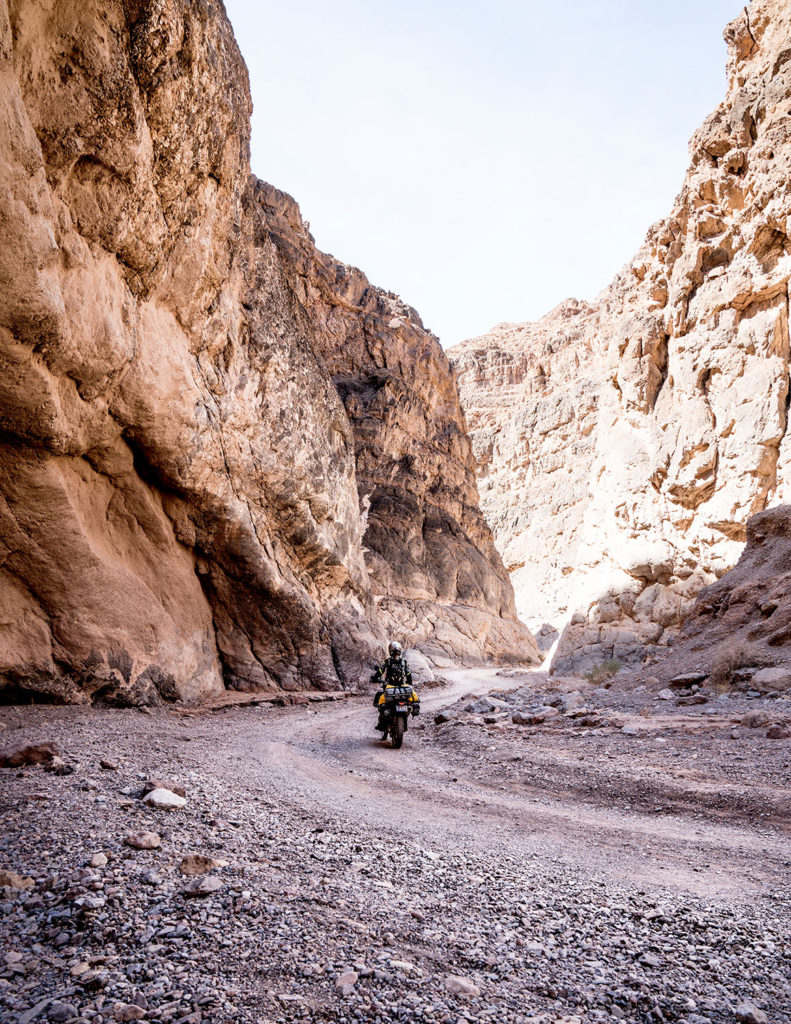
Here we go again…
What happened next is a paving slab short of a patio, so it bears being described. We’re story animals after all, where individual stories sometimes piece together human existence into a unified whole. Next stop: the Racetrack: seemed like good a time as any to attempt it again. Exactly two years ago, we were forced to leave the national park due to a failing stator on Jason’s motorcycle. Having never made it to the Racetrack; Jason was gutted then so geared up to take her on again.
“Oh, you’re kidding me! No. You’ve got to be joking.” Jason spluttered in sheer disbelief on the roadside. We were not even a mile outside of Titus Canyon.
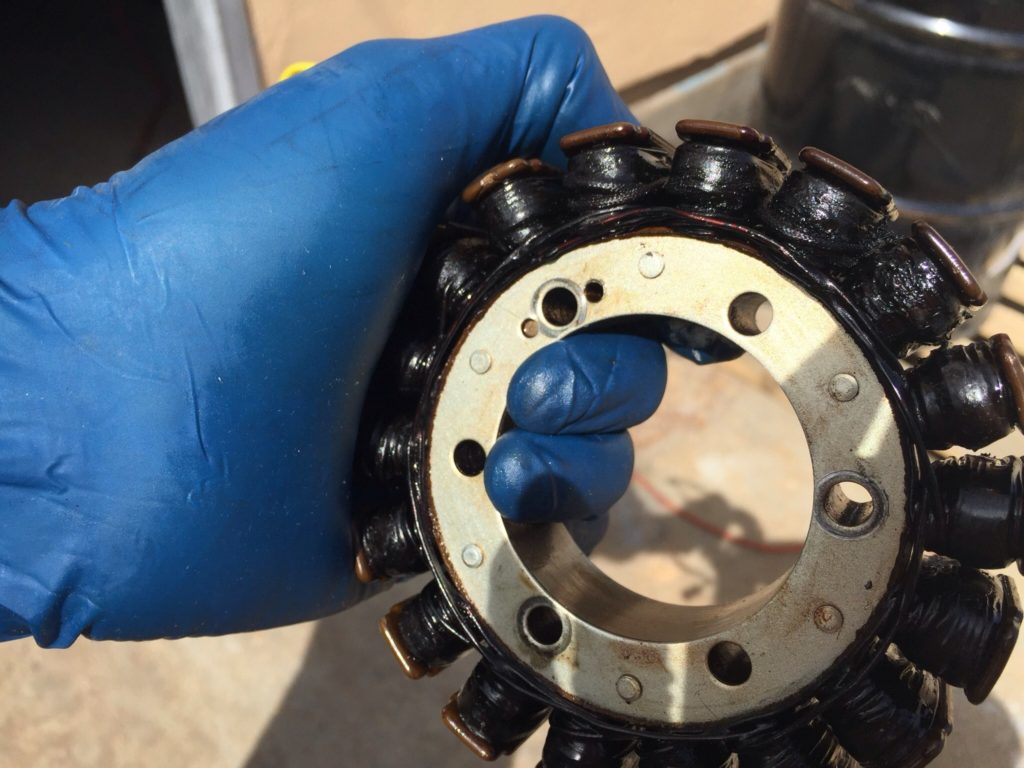
“What’s up?” Oh, don’t tell me it’s the stator, I wondered tentatively as I parked my stare on Jason. He was serious and sober as a judge, so I took a breath and put a firm lid on my high spirits at having just conquered the canyon. Aesthetic rejoicing, quiet appreciation and off-road euphoria would have to wait. Not for the first time, I felt a reassuring shiver of dislike for the F800GS. If it’s not one thing, it’s your BMW. Or at least Jason’s. Having used it again and again, it was beginning to behave like a cheap umbrella.
“That’s the second bloody stator’s that gone in two years.” Well at least you’re not bitter, I mused, refraining to verbalise the nearest off-the-shelf remark but visibly resisted saying something about leopards and their spots.
Alas, the realisation kicked in as the bike flatly refused to start. Not lost on either of us, the irony was almost comical, save for the exquisite timing. In derision, the machine gurgled to a halt and sat there radiating sadness. “I think the universe is trying to tell us something, Lisa—it doesn’t want us to go to the Racetrack.” I might have to agree, it was starting to fear of loss me too. From head to whole, I knew Jason wanted to go.
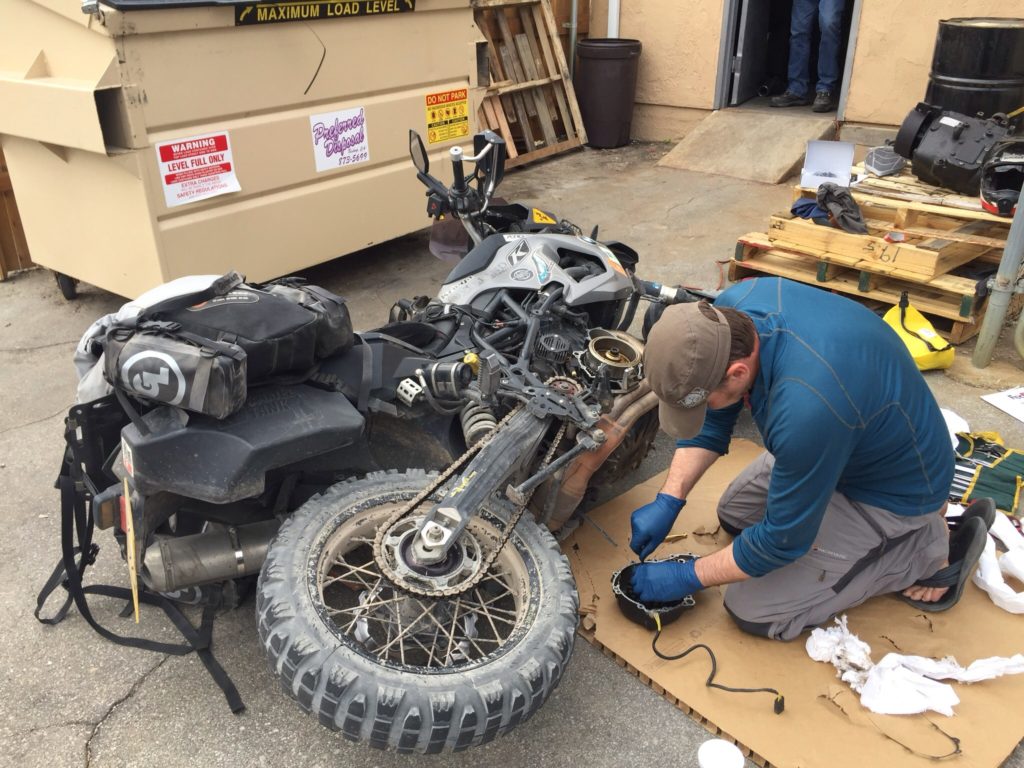
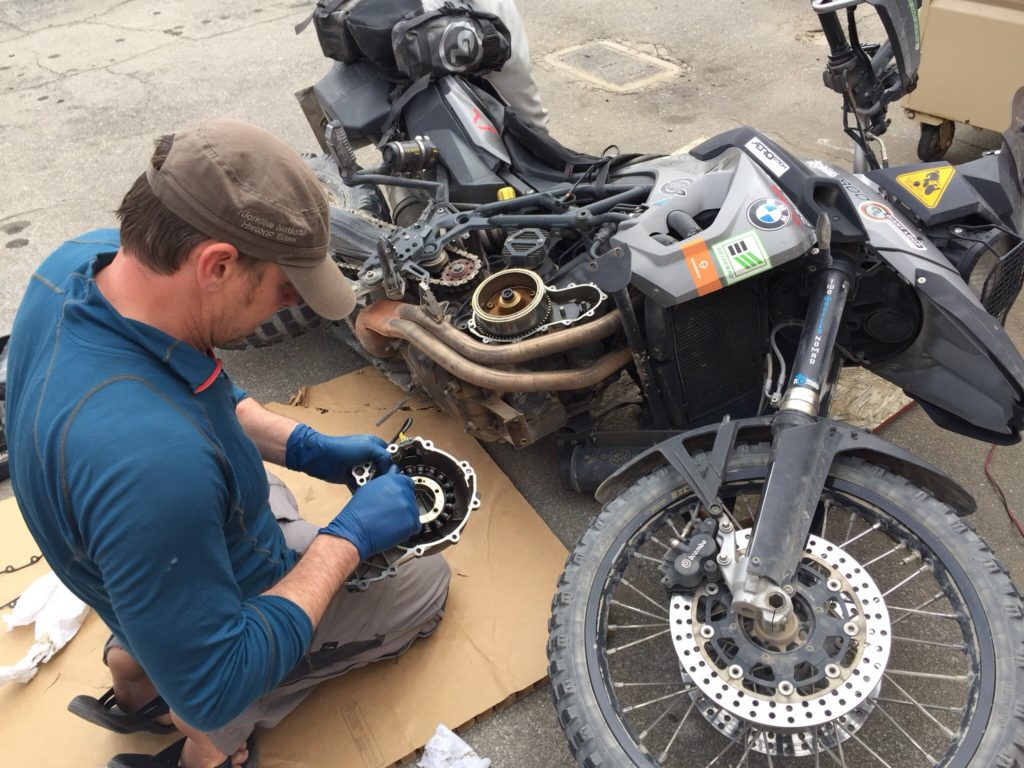
Alabama Hills, Lone Pine, CA
A surge of power from the portable battery pack and we scooted to the nearest big town. Lone Pine, where parts could be ordered, overnight shipped and thanks to Dave Mull, installed at the back of Napa, his auto-parts store. Might as well camp just up the road. There was a boulder field of jumbled rock formations and hills near Mt. Whitney, standing out against jagged granite on the eastern slope of the Sierra Nevada. The morning had finally settled into a beautiful afternoon, high clouds rolling across the big blue sky. The muted orange volcanic outcroppings, rock piles and dozens of natural arches was a scene straight out of Star Wars. These are the Alabama Hills. A popular movie set location, scenes shot here for How the West Was Won to Iron Man and Django Unchained.
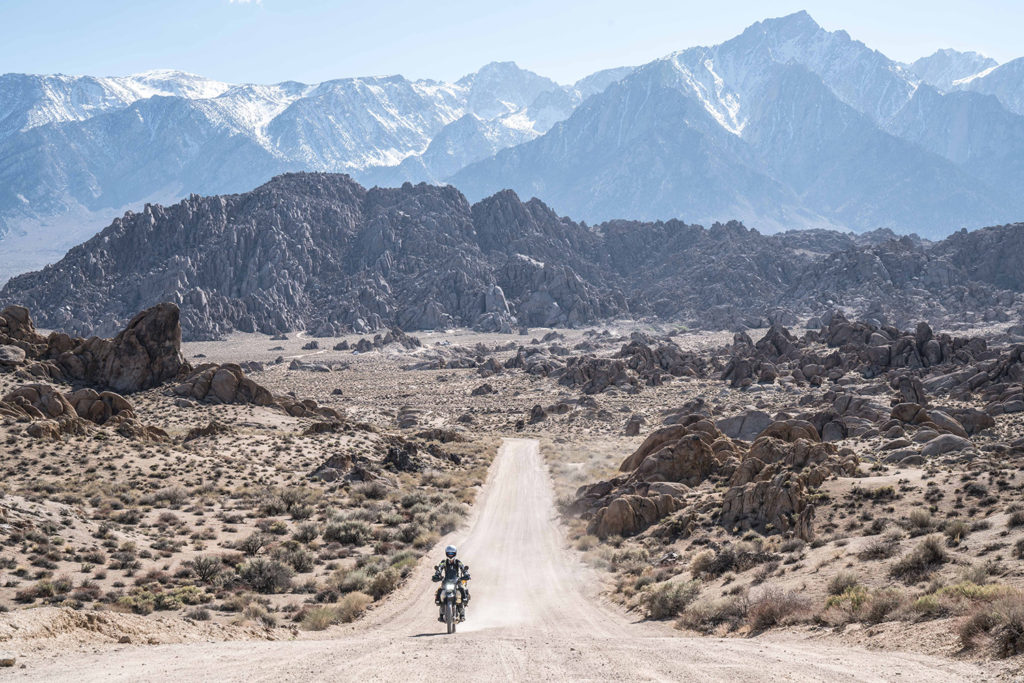
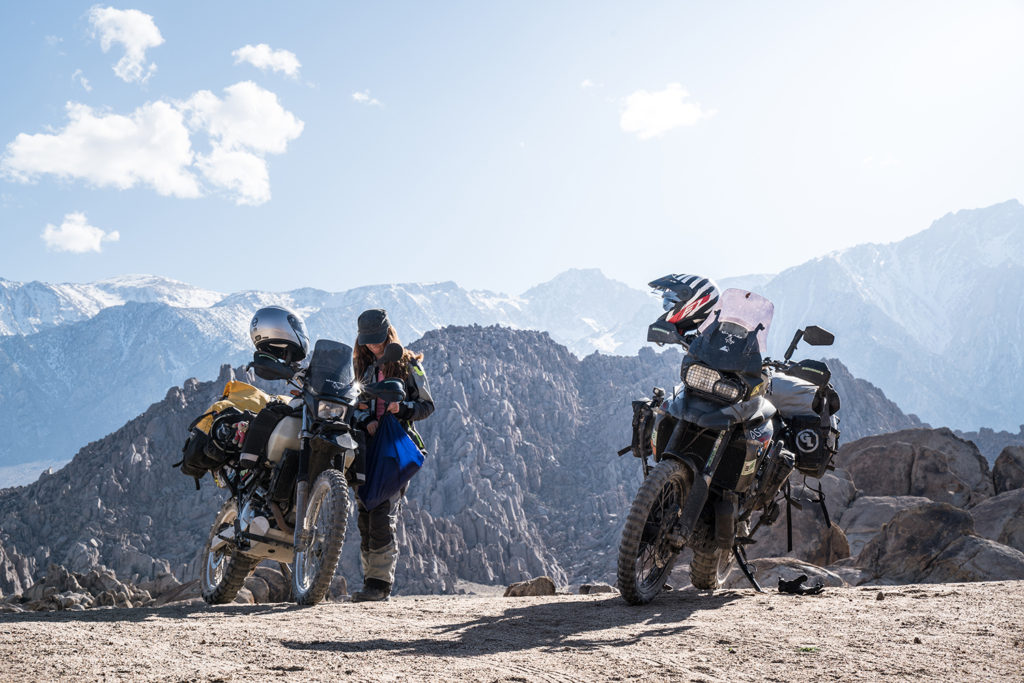
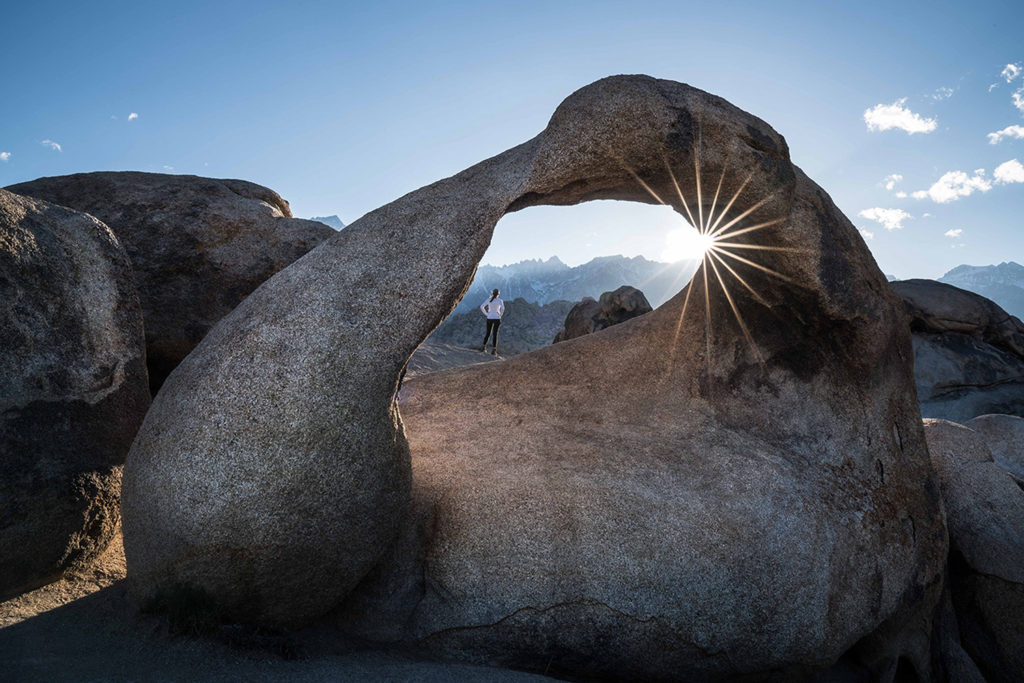
Perhaps more bewitching was at night when the stars twinkled in the night sky, a world without gravity. My mind was arrested, spellbound as it burrowed deep to understand the allure of this beguiling place.
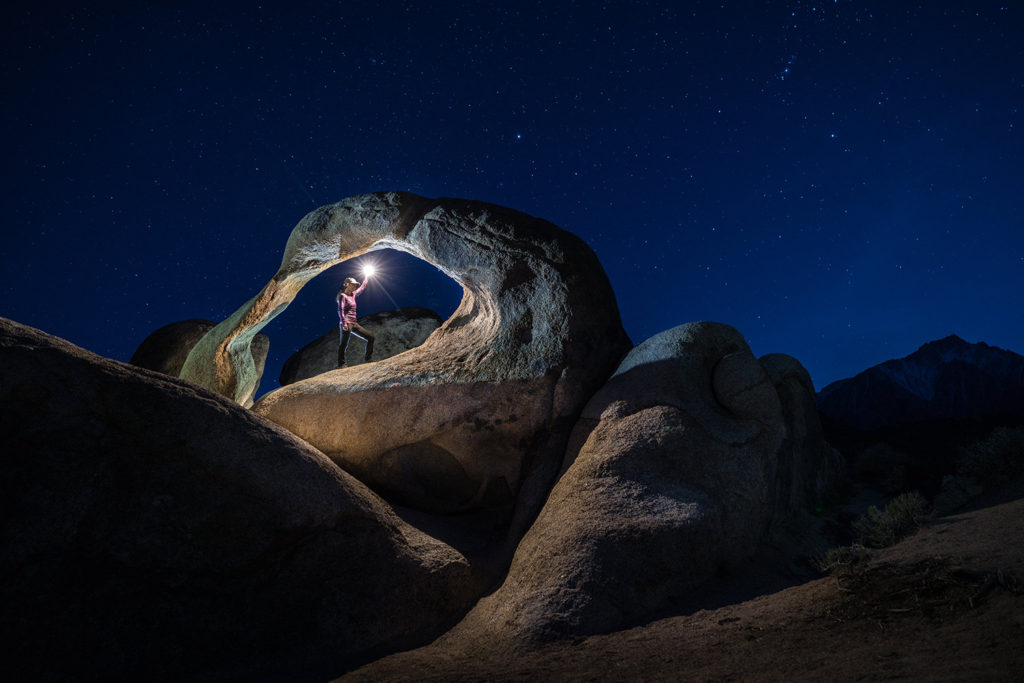
Best of all: it was BLM (Bureau Land Management)—free, public camping. Between Mt. Whitney, the highest point in the contiguous U.S., and Death Valley, the lowest point, you get these amazing weather systems that move through. It’s a real find.
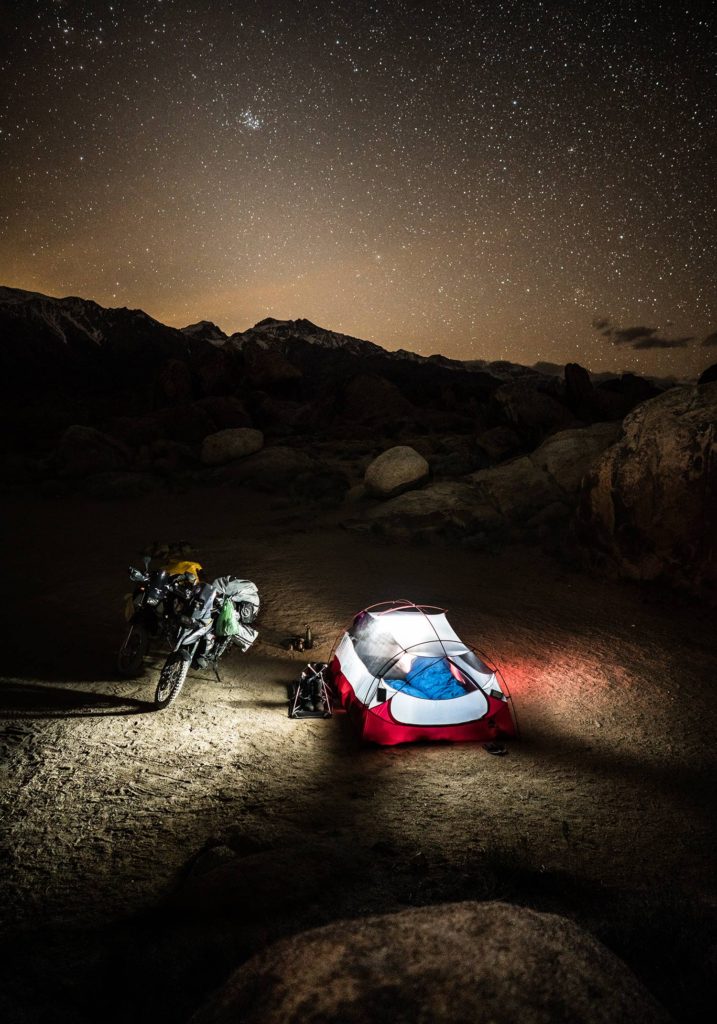
The Racetrack
Back on the same ribbon of pavement, we re-entered Death Valley. Pleasingly, we passed a meteor crater, narrow canyons, dunes and the odd Joshua tree dotted here and there. There was practically no sign of human life out here. Not until we embarked on another 27-mile bobbled ride of loose rocks, but mostly back-jarring and skull-shaking washboard.
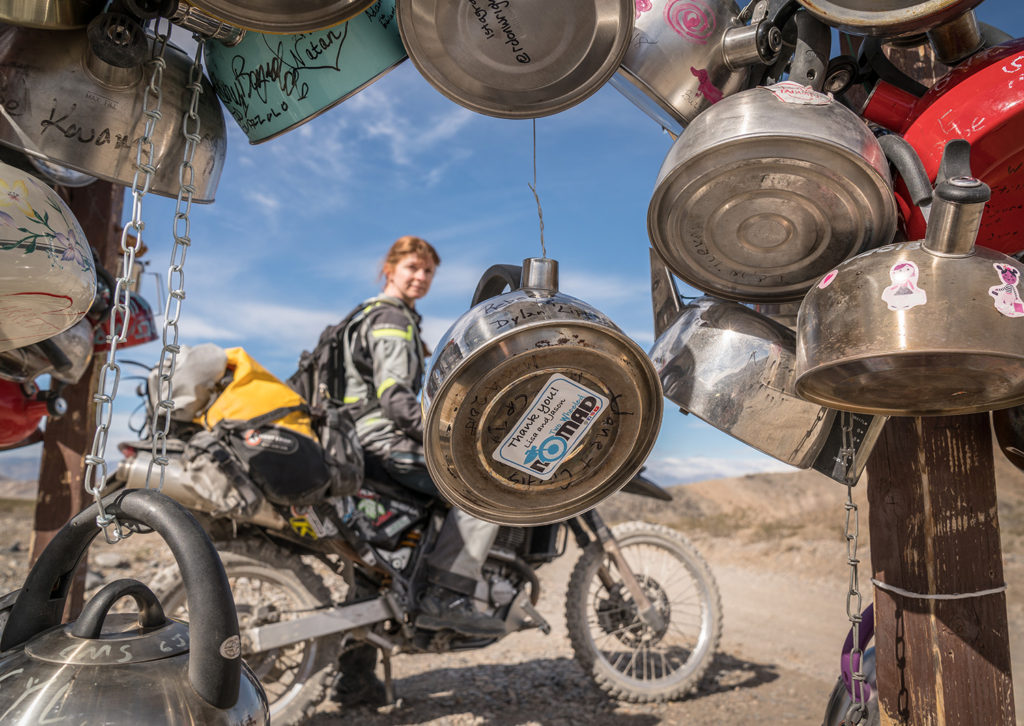
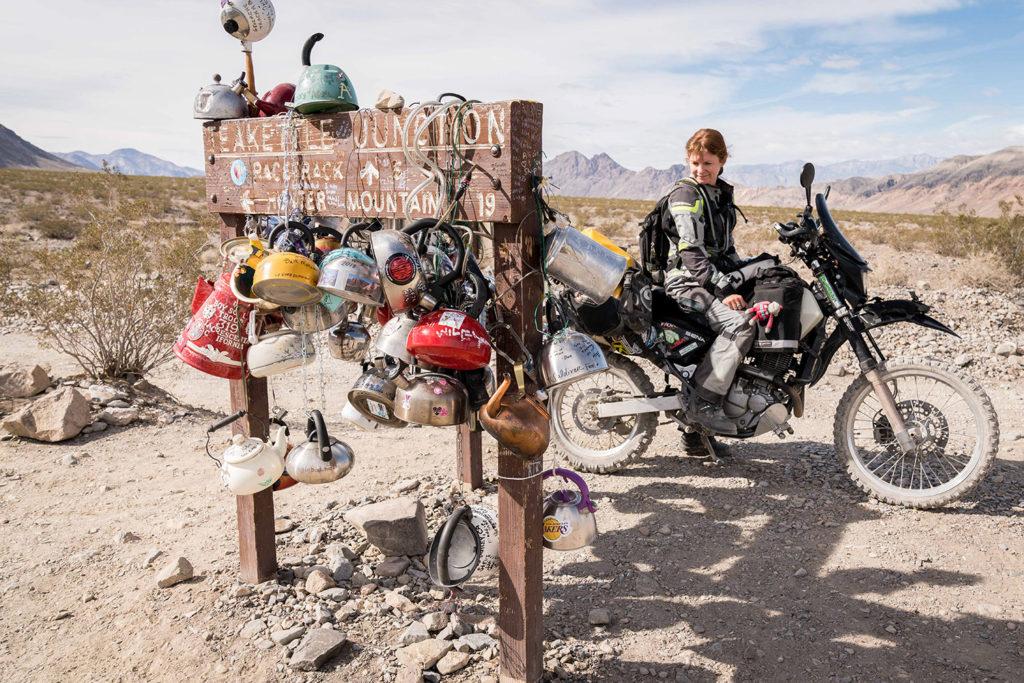
At Teakettle Junction, we rested and then rode west until reaching the Racetrack. Third time, lucky as they say. Who’s they…the wizards? Meaningless patter aside, it’s “…a curious dry lake, almost perfect oval in shape, and resembling a racetrack”—Phil Townsend Hanna observed as he witnessed the playa. Three-miles long, ringed by mountains and flat as a pancake. The dried-up lakebed is out of place even in this geologically jaw-dropping park.
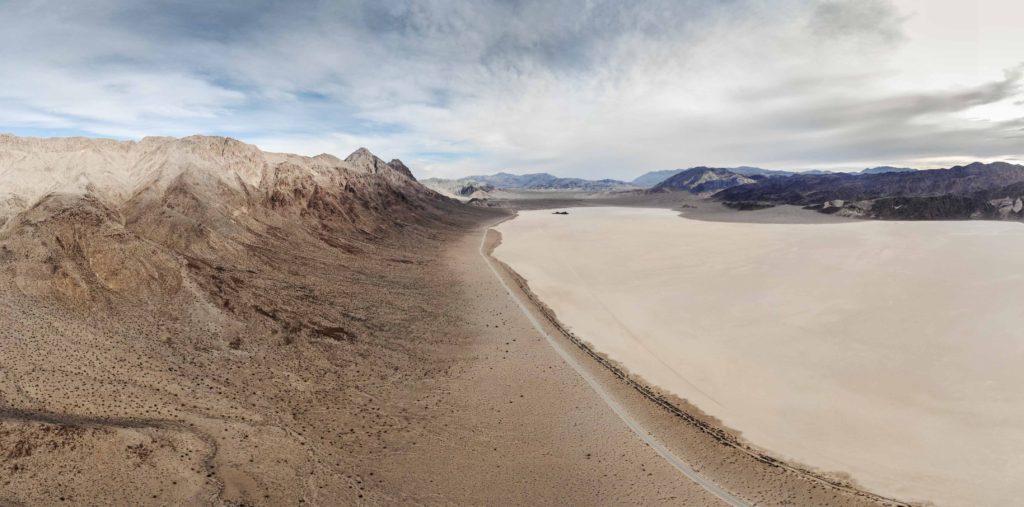
The moving stones
Famous for these rocks that tumble down the mountain, land on the playa and then somehow race around. They actually “move” by themselves across the desert marking their journey with tracks, which befuddled scientists for decades. And me, they didn’t budge an inch. Still, the sun-baked cracked floor looked ancient and felt warm underfoot. Walking barefoot to get my daily dose of electrons from the ground, I came across rocks ranging from the size of a lemon to a 700-pounder (scientists dubbed her “Karen” apparently). Most of the rocks leave a track scored in the dirt, like a snail trail etched in the earth. Some are straight and relatively short, other tracks go the length of a rugby pitch and curve or zigzag off at odd angles. Surely no magic’s involved but if they were removed from the lakebed, as some increasingly are by pebble-brained plunderers, then to my mind, all magic is lost forever.
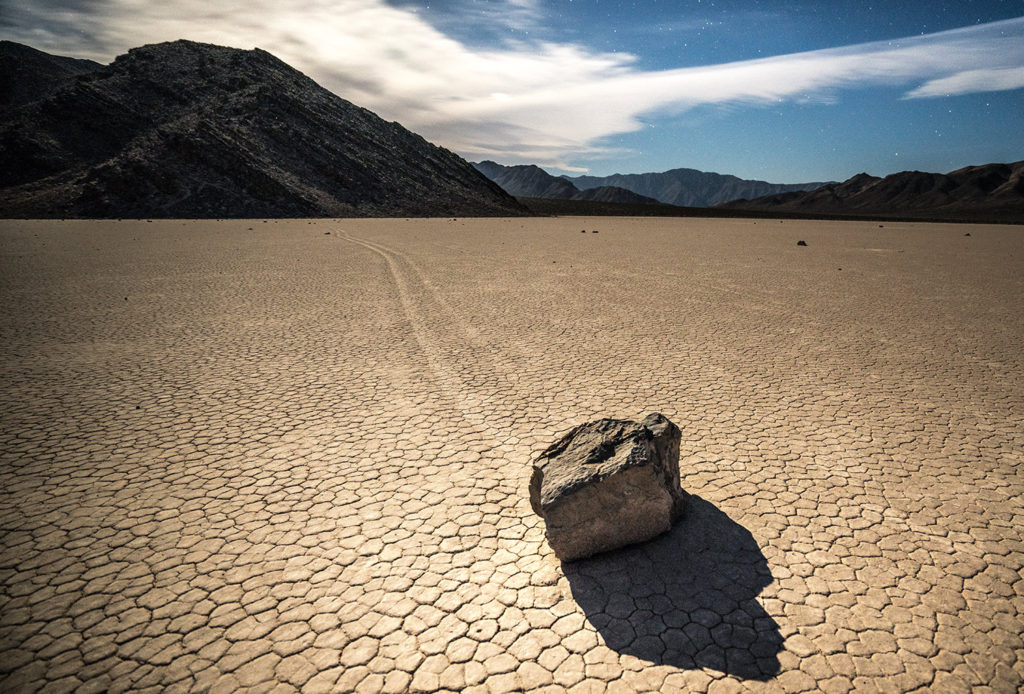
If they’re not magic, what does cause the stones to shift?
Staring down at these “slithering stones”, I was split between two realities where logic only prevails one: (i) these rocks look like they’ve sailed of their own volition across the desert floor and yet, (ii) rocks can’t make themselves move. Foremost, the mystery is still embedded in an astonishing fact: no one’s actually seen them advance! Unsubstantiated theories around magnetism, energy fields and aliens erred on the farcical. So did discerning the stones as faith objects, this was no place for wild imagination or bombast. A blend of curious joy towards the stones piqued my interest.
Cue Ralph Lorenz, a planetary scientist at Johns Hopkins University and his team who presented their findings in 2011. “Basically, a slab of ice forms around a rock, and the liquid level changes so that the rock gets floated out of the mud,” he explained. “It’s a small floating ice sheet which happens to have a keel facing down that can dig a trail in the soft mud.” The truth is usually simple, that got my buy-in and filled the trailing gaps.
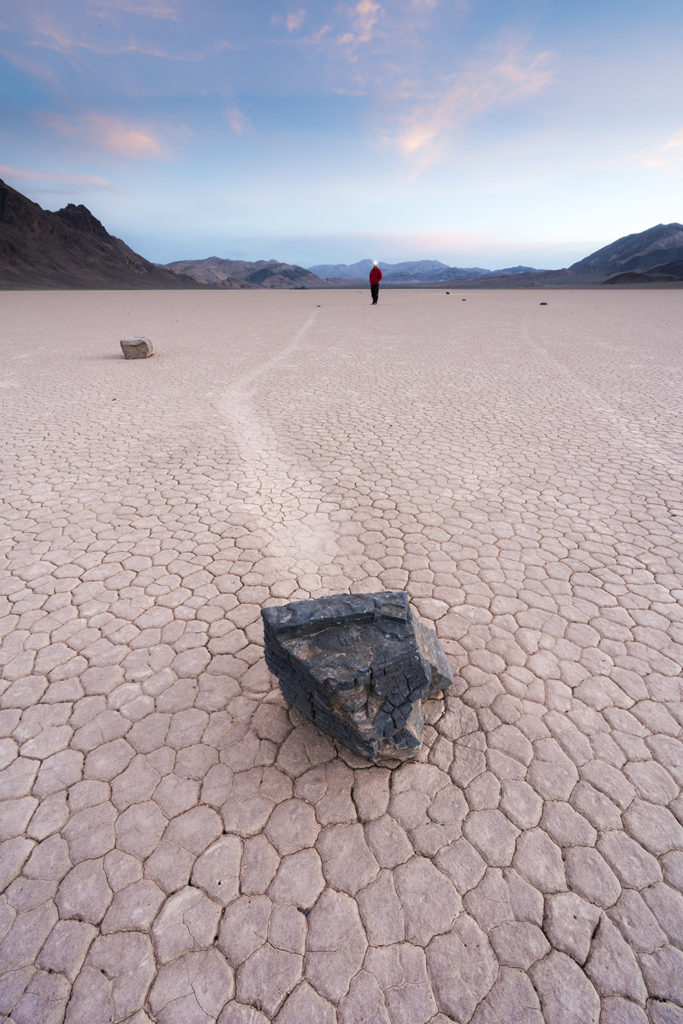
Although the official answer given to the public states in 2013, cousins James and Richard Norris unearthed a similar truth behind the bizarre marks. With sufficient rainfall, the southern end becomes a shallow lake. During winter, the lake surface freezes into a floating sheet of ice, rooting the rocks. The sun causes the ice sheets to break up, steady breezes catch the floating ice sheets—pushing them along with their embedded rocks. Eventually, the ice melts and the water evaporates, leaving the rocks relocated. That is, until the next event—maybe years later—moves them again.
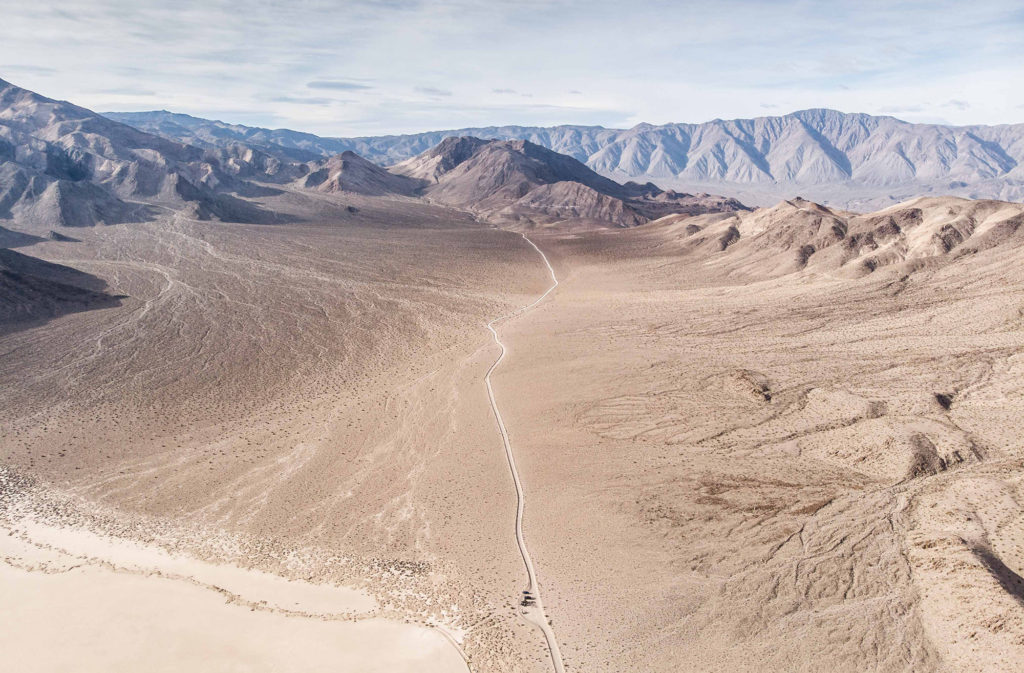
Was the bone-rattling ride to the Racetrack and “sailing stones” worth it? I think so—even if Jason’s side-stand snapped clean off on our way out. Death Valley is a killer on your bike. Or…just Jason’s! No, what the rocks are doing on their own little playa over millennia is fascinating. Back at camp, clusters of dust from the desert erupted in a fine spray that pirouetted around us as we sat watching the sun melt into the mountains. Overcome with weariness, an impromptu party with some great guys and a travelling nurse we met, sleep crept through my veins like anaesthetic. Tired, I sank like a stone into a deep slumber.
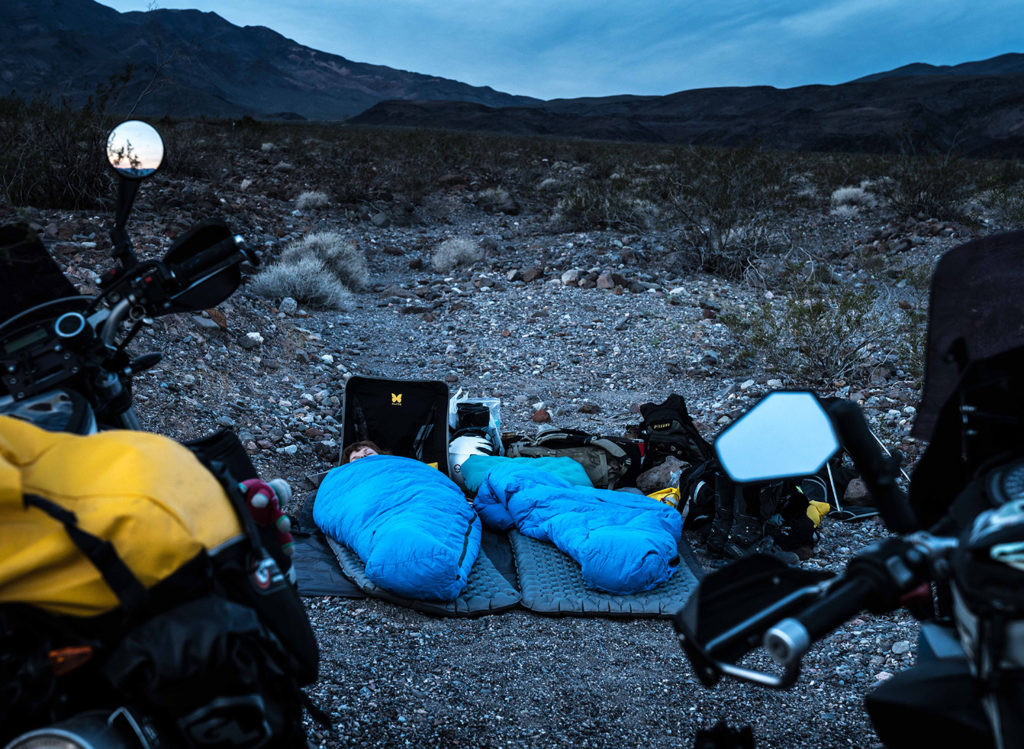
Eureka Valley Sand Dunes, Death Valley National Park
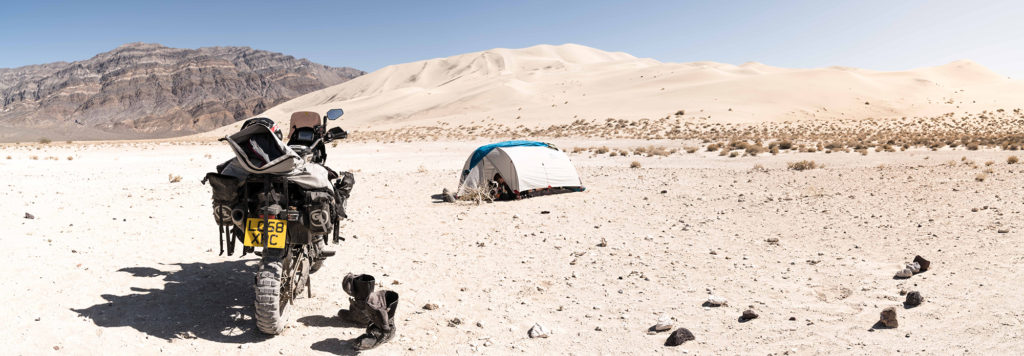
As the first pale fingers of light pried my eyes open, we wended over 15-miles of good gravel in the Eureka Valley, and descended on the Eureka Dunes, sparkling on the horizon. Rising to around 700-feet, it’s one of the highest dune fields in North America with dry camping and concrete picnic tables located at the sandy bottom. Unusually, they’re also known as “singing dunes”. At certain times when the wind’s just right, they produce a high-pitched whistling sound.
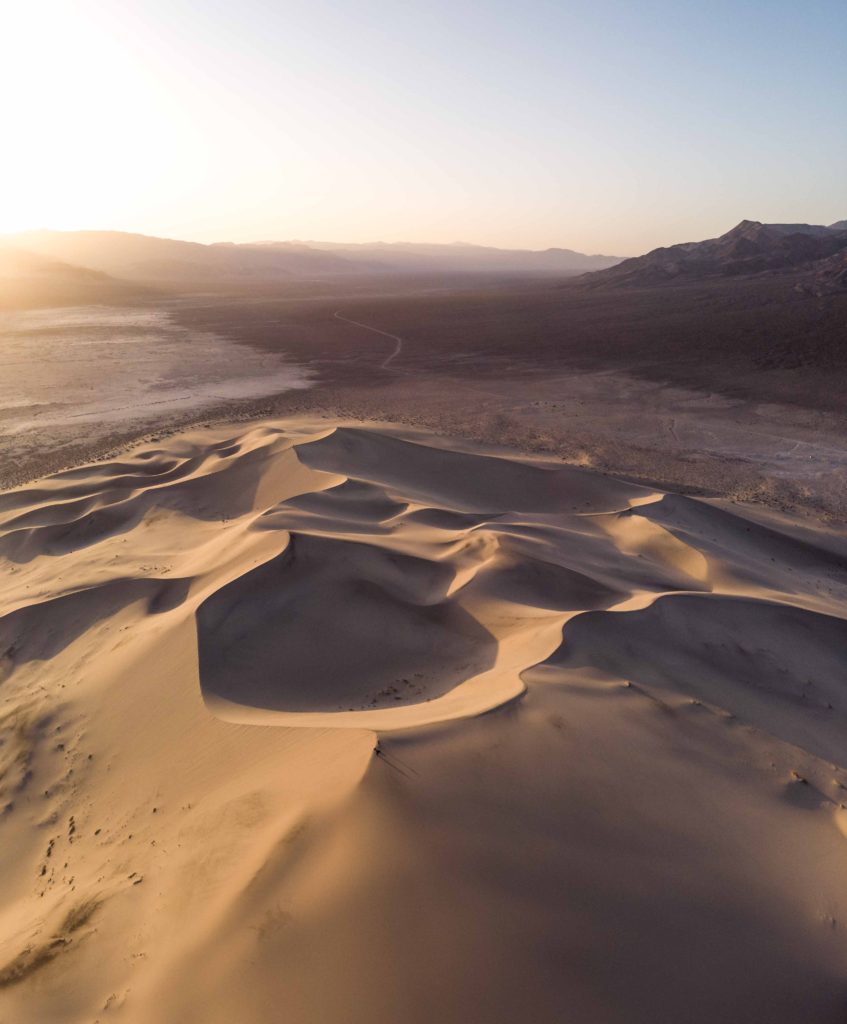
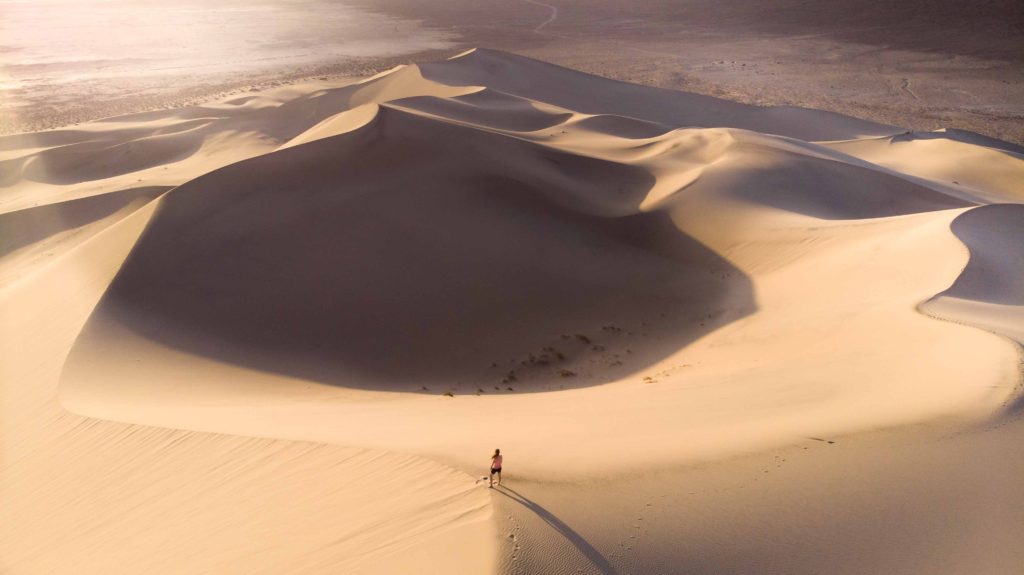
While no soothing tunes emanated from the dunes for us, they whispered softly as the breeze whipped the sand around our feet. Magnesium white in the morning sun, they later take on a golden glow, which intensifies as the sun sails westward on its afternoon journey. With every curve and striation on the sand burnished red by the setting sun, it’s perhaps the last place I stood that completely bowled me over.

My heart thumped, my skin tingled, and a dawning sense of paralysis slowed my feet upon each barefoot climb up the steep slopes. Keep pushing, Morris! The thigh-burning throb will be worth it as I withdrew into my own jagged thoughts.
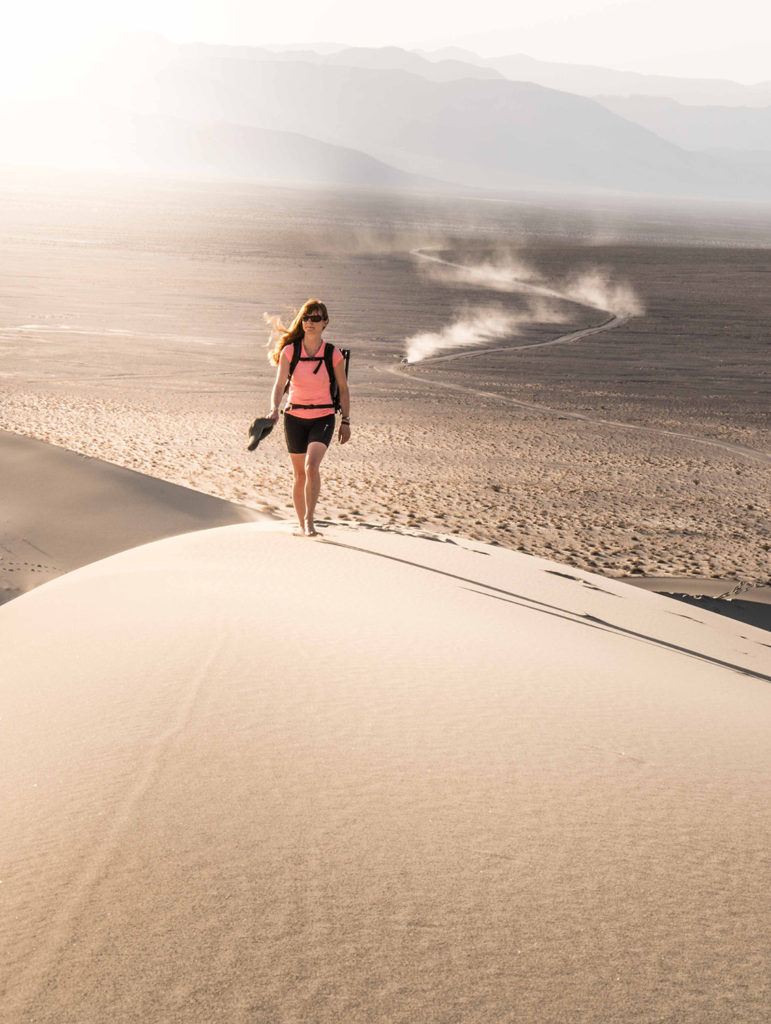
Hot and breathless, each heaving effort led us to magnificently sharp ridge lines split perfectly by the stark shadow; by daylight, twilight and moonlight.
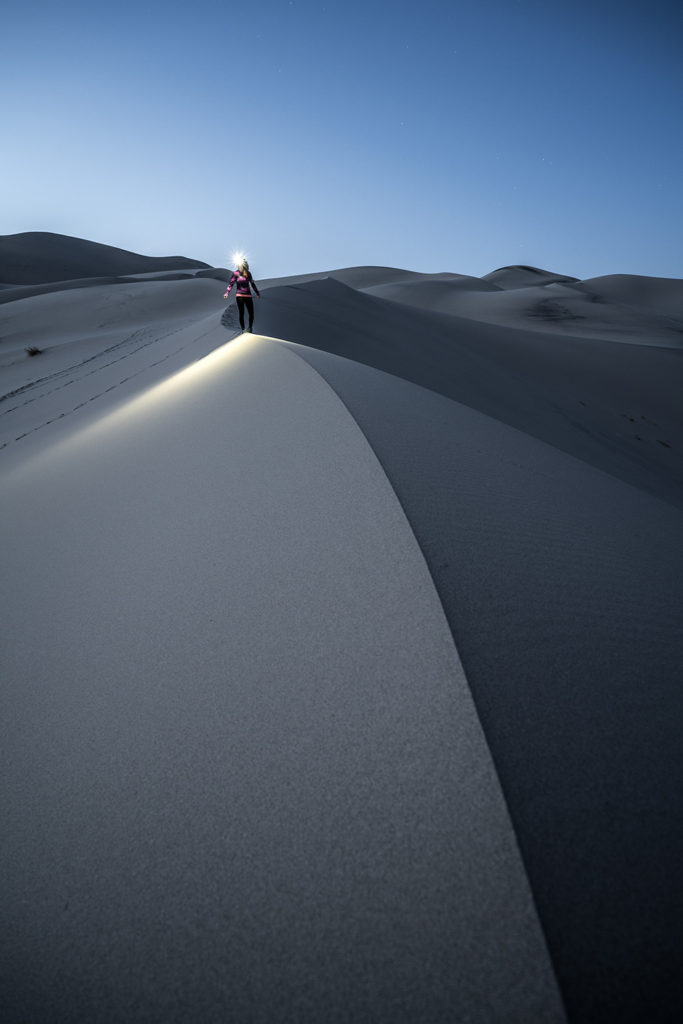
Wow, it was stunning stomping ground in the remote desert wilderness. And just like the valley in which they reside, offered a raw, grounding purity you can turn to for replenishment. In the very dreamy and earthly locale in which I now found myself—seeing is believing.
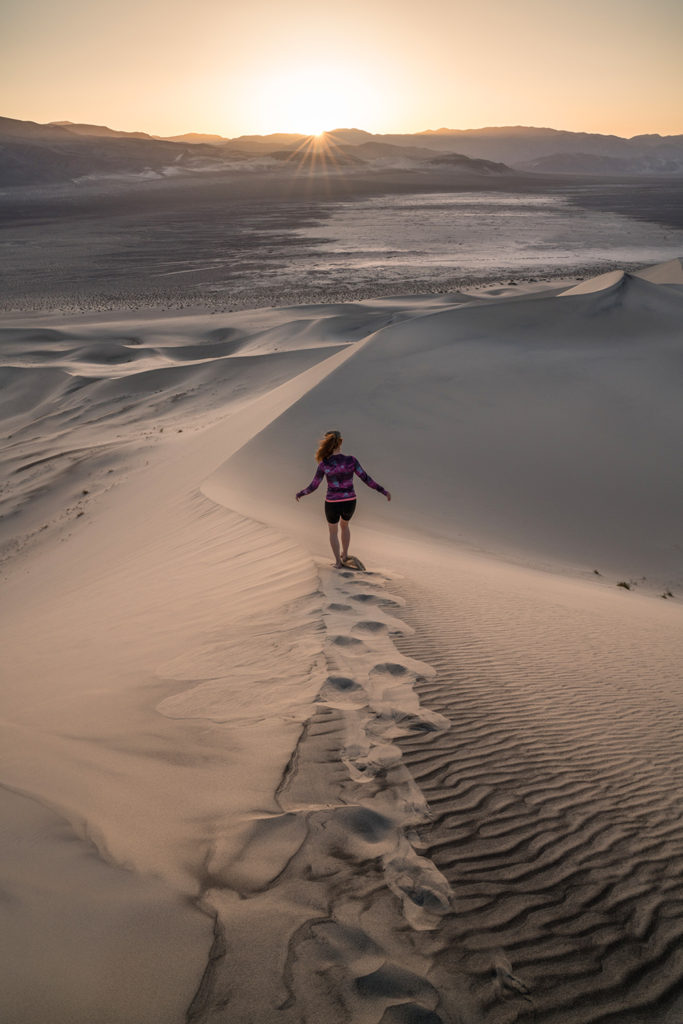

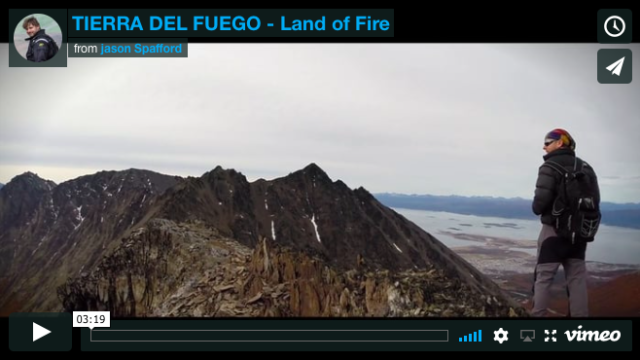
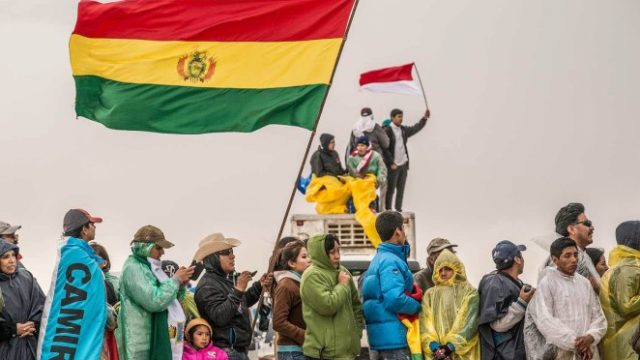
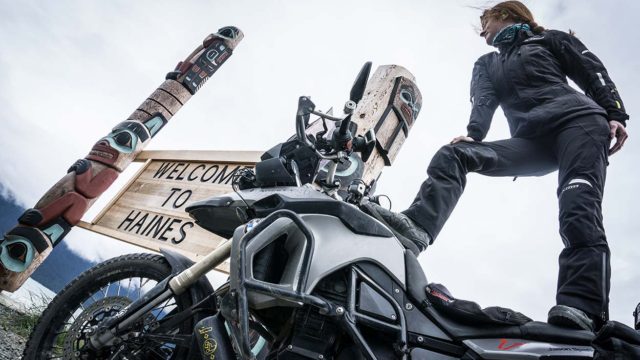
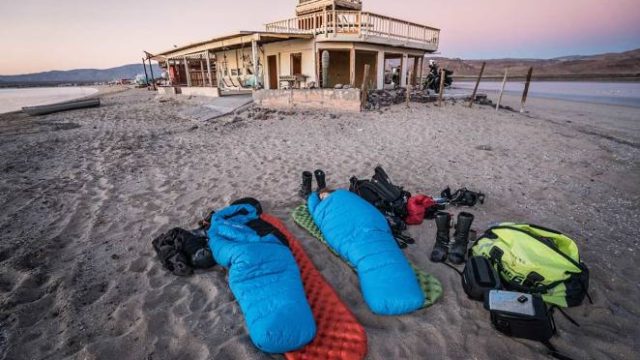
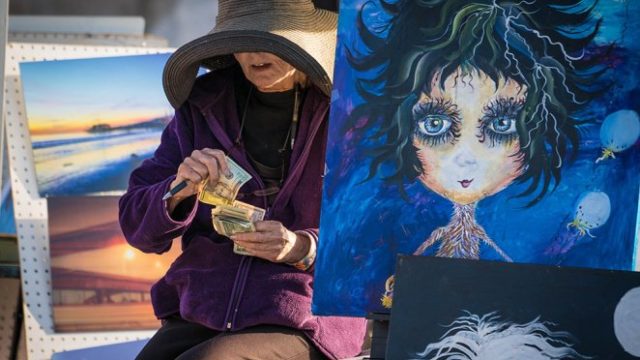
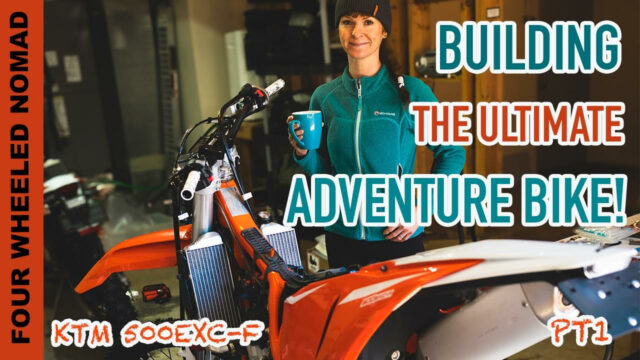
Good post. I absolutely love this website. Thanks!
You’re most welcome. L&J
Very good post. I certainly appreciate this website. Continue the good work!
There is certainly a lot to know about this issue. I like all of the points you’ve made.
Very good blog post. I absolutely appreciate this site. Keep writing!
awesome post thanks